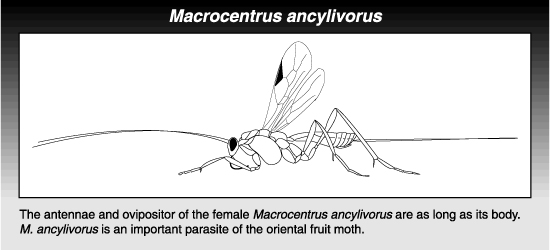by Jay F. Brunner, originally published 1993
(Hymenoptera: Braconidae)
The genus Macrocentrus includes several species that have been reported attacking pests of fruit. They are only known to attack first instar through nearly full grown larvae of Lepidoptera. M. ancylivorus, which is native to North America, historically has been recognized as being one of the most important in the genus and has provided effective control of the oriental fruit moth. In California, the release of M. ancylivorus plus minimal insecticide use have been reported to give as good control of the oriental fruit moth as a heavy insecticide program.
Hosts
M. ancylivorus attacks the strawberry leafroller and oriental fruit moth. It uses fruitworms, stemborers and other leafroller species as alternate hosts.
Life stages
Egg
The egg is 1/250 inch (less than 0.1 mm) long and is deposited inside the host larva.
Larva
There are four larval stages. The first three instars occur inside the host body, while the fourth feeds externally, consuming the host body contents. The last instar is 1/6 to 1/5 inches (4 to 5 mm) long.
Pupa
The pupa is contained inside a cocoon spun by the last larval instar near or within the cocoon of the host. It is about 1/6 inch (4 mm) long and is a glistening brown color.
Adult
The adult female is 1/6 to 1/5 inches (4 to 5 mm) long with an equally long ovipositor and antennae. The body is slender and reddish brown to yellowish in color. The male is 1/8 to 1/6 inches (3 to 4 mm) long.
Life history
The egg hatches soon after being deposited in the host larva. Any larval stage of the host may be attacked, though eggs are not laid until there is some webbing or frass. When the host larva matures, stops feeding, and spins a cocoon, the parasitoid larva completes development. The fourth instar M. ancylivorus leaves the host’s body and feeds externally until ready to pupate. The parasitoid’s larva spins a cocoon within the cocoon of the host. M. ancylivorus takes about 7 days longer than its host to develop, on average. Because of this, emergence of the adult parasitoid coincides with the egg hatch of the host so the adults have host larvae available to attack. There are as many generations of M. ancylivorus as its host, usually 3 to 4 for the oriental fruit moth.
Monitoring
Presence and abundance of M. ancylivorus can be monitored by collecting twig strikes and infested dropped fruit, placing them in a container and counting the number of oriental fruit moths and parasitoids that emerge.
Management
M. ancylivorus was mass reared on the potato tuberworm, Gnorimoschema operculella, for release in orchards in the 1940s and 1950s. While this research was mostly conducted in the eastern United States, the results were encouraging. Release of 3 to 5 M. ancylivorus adults per tree, either alone or in combination with a reduced insecticide treatment schedule, effectively reduced damage by the oriental fruit moth on peaches. M. ancylivorus is evidently a strong flyer and will readily disperse from the release orchard, so regional release programs might be the best strategy to follow. Extensive use of insecticides in Northwest peach and nectarine orchards has probably prevented M. ancylivorus from having a significant effect on oriental fruit moth populations. M. ancylivorus could be used to enhance control of oriental fruit moth in orchards using mating disruption and where soft insecticides, such as Bt products, are used to control peach twig borer.

